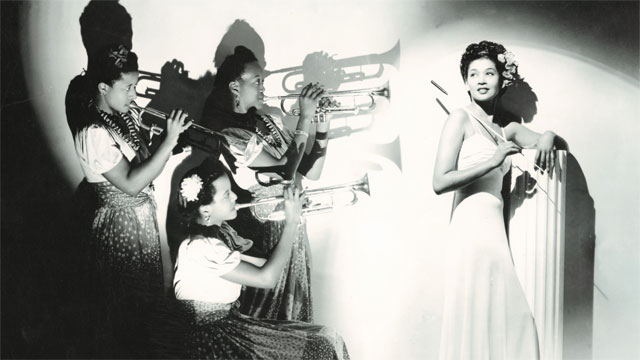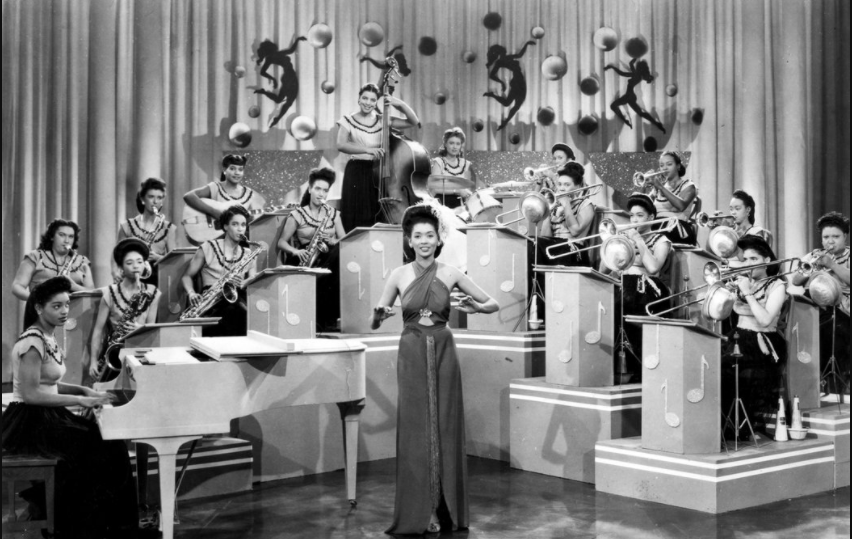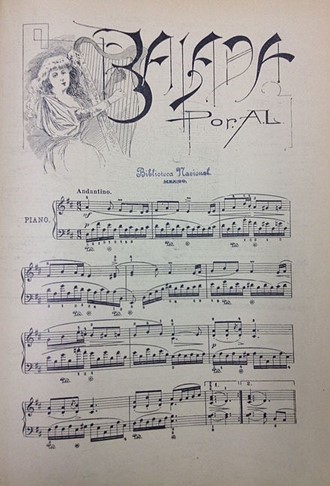
By: Estefanía Romero
This is a theoretical trail on the role of women in jazz history, and it offers reasons on why there is such a reduced presence of females in this kind of music. Also, my research exposes a series of interviews to Mexican women who belong to the jazzistic guild, as an experiment to determine if they perceive a reduced presence of women in the Mexican jazz circles. And if so, what are the reasons for it.
It is scientifically proven that there are no differences on musical capacities between men and women. Even though, this analysis shows that in Mexico women are still less in the jazz ecosystem (probably less than 10% of the total jazz players). Some causes are: the instruments gendering, the tendency of making late acknowledgments, the lack of promotion in media, the lack of preparation, the dependence on the work of man, the lack of media representation, the fear of nocturnal work, the fear of exposure and criticism, the reject from projects created by men, and harassment. It was also found a strong consideration that most of jazz women in Mexico tend to be hired (and promoted) when they fulfill a physical standard of attractiveness.
Finally, this analysis considers that for every two female singers there is a female instrumentalist of jazz in Mexico. However, most of the “jazz singers” lack (somehow or even completely) of education on the jazz language.
I invite you to read the next parts of this article:
|
First Part: The Notion of Inferiority
Origin and Objectives of the Research: “Are Musician Women Inferior?”
The work you are reading has a big debt to Keeping Time. Readings in Jazz History, by Robert Walser (1999), when he pointed out an anonymous article published in Down Beat, under the title: “Why Women Musicians are Inferior?” (1938). This publication was followed by other demands on the same magazine, which tried to argument the positive or negative role of women in jazz bands. This moved me and I needed to know everything behind it.
At the beginning, my only objective was to obtain some knowledge, but when I almost finished writing this article, I knew the implications were wider and way more important: knowing that there is such a reduced number of women in jazz allows us to identify gender stereotypes in our own society, which directly influences the individual decisions on how to (or not to) take part of the music practice.
As a critic, I always insist on bringing the Mexican jazz to an excellence status, but now I am even more worried because I am taking conscience that behind music itself there is a whole social reality with complexities and difficulties that we have been ignoring, or that we haven’t known how to deal with for a long time.
Hence, this material intends to identify such paradigms, looking to start a conversation about them, as much as to find solutions to grow as a fair society when it comes to gender, to create a place that cares about its artists. Maybe that will allow us someday to have more and better male and female jazz musicians, who will have enough rights to develop themselves with dignity, and who will also be conscious about their responsibilities (musical and social ones), when they call themselves “jazz players”.
How Man and Women are Supposed to Act: Gendering of the Instruments
Biddy Haeley (2016) quoted a statement published in the 50’s in Down Beat: “good jazz is a hard, masculine music with a whip to it. Women like violins, and jazz deals with drums and trumpets”. This, which Haeley considers as the root of the problem, is what she conceptualizes as “gendering”, a term first used by Abeles and Porter, to name the notion that considers the piano, the violin and the flute as feminine instruments, whereas the drums, the bass and the guitar are highlighted as masculine instruments. The same authors, according to Haeley, found that parents have a significant role in influencing children with the notion of gendering, so that these accept or reject an instrument according to their sexual identity, and this usually happens in an age as early as four.
Healey appeals to O’Neill and Boulton, who identified kids that rejected certain instruments that were linked to opposite genders of their own; and McKeage, who obtained the idea that playing a ‘non-jazz instrument’ was the main reason women cited for not being part of jazz ensembles.
All of this has a historical fundament. In his article “Jazz and Gender during the War Years”, Robert Walser (1999) explains the political and cultural believes of the time in which jazz became globally popular. Walser distinguishes a debate that came up after the changing structures of the work force un the US, during the 30’s and 40’s. The Great Depression and the Second World War were the reasons why women started working like never seen before. Thus creating “tensions with prevailing notions of gender identities –how men and women were ‘supposed to’ think and act” (p. 111).
Walser points out that the ideas about “femininity” were on the public conversation, so the issue was exploited by magazines as Down Beat, The Metronome, Cinema Journal, American Music, Representing Jazz, and some books. Arguments on female big bands came out. The most popular of these was probably the multirracial International Sweethearts of Rhythm, founded in 1937; which created controversies on the social roles of women in jazz.

An interesting observation from Walser is that “while many jazz critics championed racial equality, gender was different: prejudice and cruel disparagement seem to have been more acceptable for this social category” (p. 111).
In “Why Women Musicians are Inferior?”, the anonymous author (1938), indicated that: “There are several psychological reasons underlying the apparent futility of women in dance orchestras, especially applicable to wind instruments. In the first place, women are as a whole emotionally unstable, which prevents their being consistent performers on musical instruments”.
In the end, the anonymous voice wrote that the piano or the string instruments are more suitable for women’s characters. He said that there are no good women percussionists. Ironically, if we look closer at these arbitrary conceptions, they also have had an effect on men. The idea that the piano is only to be played for women was, actually, the reason why Jelly Roll Morton got frustrated at the beginning of his career: “I didn’t want to be called a sissy […]. So I studied various other instruments, such as violin, drums and guitar, until one day at a party I saw a gentleman sit down at the piano and play a very good piece of ragtime” (Roll Morton, in interview with Alan Lomax, 1938; quoted by Walser, 1999, p. 17).
In my conversation with Tootie Heath (Romero, 2019), the iconic nonagenarian drum player revealed an anecdote:
Tootie: My older brother, who was learning violin, I don’t know who his teacher was ’cause it was long before my time but… anyhow, he’d drop that because he said “with a name like Percy and carrying a violin home from school was not very popular”, because in those days they associated “Percy” being a strange name, which was kind of homophobic… Percy with a violin, it was too much pressure for him.
Estefanía: [Considered to be] An instrument for women, right?
Tootie: Yeah! So he would stop playing the violin. He stopped! And then some years went by with him not playing, he would in the military, and he became what historically is called now the “Tuskegee Airman”.
Anyway, we can always find different cases. The documentary The Girls in the Band (Chaikin, 2013) narrates a story: Gene Norman, host of the show “Stars of Jazz”, presented Marian McPartland, saying: “From a physical standpoint, famous women in music do best when they play the piano. This is probably because it takes less physical effort to play the piano than a, let’s say… wind instrument or, for that matter, the drums”. While saying it, the host and recognized jazz producer didn’t leave much room for us to understand if his comment was going serious or if he was being sarcastic. He was serious to me. Norman asked McParland: “Honestly, do you consider that you are working under a heavy cap to make a profession of being a jazz pianist as a woman?”, to what she answered: “This’s never been a heavy cap, Gene. Now that I think about it, I just think of myself as a musician working with other musicians”.

In a conversation on this subject, Miguel Almaguer (composer, conductor, writter and History of Music professor for different universities around the world) mentioned that this gender stereotype didn’t really started with jazz, but it has existed since the Romanticism started in Occidental Countries, hence, in the Mexican elite during the same time. According to Almaguer:
“Women [in Mexico] would play piano, that was a fundamental part on their education. It is known that they would consume magazines such as El mundo ilustrado (published from 1894 to 1914), which contained matters on literature, culture, good manners and partitures, because it was expected from high society ladies to play during gatherings. Men weren’t supposed to do it because it was considered too feminine. Paradoxically, women would play on private, whereas man had the right to become famous”.

“Women Musicians Not Inferior Says Rito” (Río, 1938)
As stated by Walser (1999), the same year of the anonymous article, Down Beat printed a few words by Rito Rio, the leader of the most successful white women jazz band of the moment: the All Girl Orchestra.

Rio claimed that “the first very essential requirement necessary to obtain desired results is endurance” (p. 113) and said that her project had been applauded for it in particular, during their tours and spectacles. Adding that “a second and important point is the feeling, tone, and phrasing which good musicians must obtain. This is a quality which girls alone are more likely to possess because of the aesthetic nature of their sex”.

Rio included a few words on cooperation:
“Rhythm in our modern swing generation is also of most important consideration, and I notice girls, because of their feminine tendency, cooperate to make a rhythm section a united unit dependent on each other, rather than the masculine tendency to deal on his own instrument” (p. 113).
In the end, her last remarkable comment is that: “Girls find a pleasing picture does not detract from good musicianship or from thoroughness and preciseness which help you to comprise the attributes of good musicianship” (p. 114).
Thankfully, time has given us neuroscientific sources. Healey (2016) answered an important question: “Is it possible that men are naturally better suited to the particular demands of jazz and improvisation?”. She explains that on the report of four papers there isn’t a meaningful statistical difference between women and men, and their ability to improvise. She uses Charles Schmidt (2007), to maintain that there is no link between genders and the motivation to practice; she also quotes Gina Wych (2012), when she said that “gender has no effect on one’s ability to succeed at learning a particular instrument”.
Even though, Haeley stablishes that several studies have found certain differences on the way brains behave. The author wrote:
“A 1996 study found that during completion of music tasks females tended to have significantly higher inter-hemispheric coherence values when compared with males. A different study found male musicians had a significantly bigger anterior and posterior corpus callosum than non-musicians, whereas being a musician didn’t seem to make a difference to women’s brain size or activity. The researchers said this was most likely because the female brain already has more symmetric organization than the male brain. Studies of children and adults found various differences in brain activity (males had more front to back activity, while females had more inter-hemispheric activity). But while activation patterns differed, the studies found ‘no difference in the behavioral performance between both genders”.
In addition, the studio “Sex Differences in Music: A Female Advantage at Recognizing Familiar Melodies”, by Scott A. Miles (et al, 2016), found that women tend to recognize melodies easier than man, even if these are musicians, which means a higher level of musical cognition from women. In the end, this research didn’t dig into the possibility of any significant influence of gender on the individual’s musical performance.
It is important to highlight that not all women have the same perception of them being rejected because of their gender. I reached Hiromi Uehara, (whose career started in Japan but got a great impulse in the US, and has expanded internationally) to ask for her thoughts to what she answered that these were difficult issues to answer because she has never really had to face any problem for being a woman, either she has been discriminated because of that. She respectfully commented that she has only been herself, without difficulties, and she doesn’t consider herself to be the accurate person to answer that kind of questions.
I invite you to continue reading this article:
|

